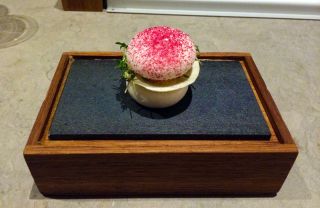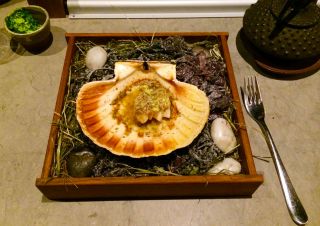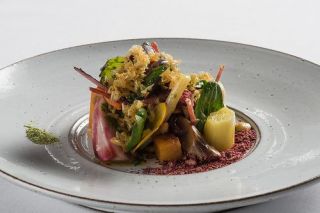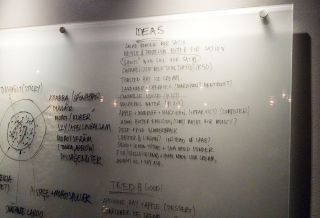Creativity
Innovation in Haute Cuisine
One of the most exciting arenas of innovation is in the world of haute cuisine.
Posted October 3, 2014
One of the most exciting arenas of innovation is in the world of haute cuisine. You really can't get away from the foodie scene with celebrity chefs on TV, hit movies about the journey from rags to riches via food trucks, and even if you aren't a foodie, you probably have dozens of friends who are.

The reason the world of cuisine is so exciting is because we now eat like kings... literally. For example, today we can pick up a phone in Paris and order the same duck l'orange that King Henri IV in the 1600s did, from the three star restaurant Tour D'Argent… take out for a king. This restaurant, famous for nobility fighting duels over reservation mixups, scoured the world for delicacies and was the first to introduce things like crepes suzette and the concept of coffee after dinner. Eventually, duck l'orange was deemed so delicious that it was declared that every duck should bear its own number and this ritual is still carried on today. In other words, hands off common folk, this dish is so good that only royalty should be allowed to eat it.
Fast forward five hundred years, and we can all now eat better than kings. True, various governments are still trying to prevent us from eating delicacies like foie gras and blowfish, but in general, we can enjoy foods that even Henri IV could only dream of. Cuisines from around the world, fusion foods, molecular gastronomy. It’s really a brave new world for your palette.
I recently had an interesting dining experience, dining at one of the world's finest restaurants with the head chef explaining the innovation that went into each dish. And so, like an ersatz Anthony Bourdain, I showed up at Frantzen in Stockholm (which made it to #12 in the definitive list of the world's 50 best restaurants).

Frantzen is a bijou restaurant in the old town part of Stockholm that serves a rare and unique blend of Nordic ingredients – the majority are from Sweden, including many harvested from the restaurants own farms. It offers a compact but elegant dining room, and Bjorn Frantzen has created an exceptional symphony of tastes blending French bass notes with Scandanavian harmonies and occasional Asian flourishes.
They arranged for me to sit with the head chef, Jim Löfdahl, who explained the design and conception of every dish, using a pen to point out interesting features of the dishes. He was a fountain of culinary knowledge, even explaining things like the history of butter - which wasn't invented by the French, but by Vikings, who would transport it on their ships, in barrels of salt water, wrapped in seaweed. He clearly and eloquently explained that their primary inspiration was the search for ingredients - all provided by local, artisanal farmers and sustainable fishermen. For example, they are constantly searching for the most delicious lobsters from the coldest waters, the crispest and most flavorful vegetables, what have you. I wasn’t bored for an instant, because Jim and crew have mastered the art of culinary storytelling.

For example, when I mentioned that their veal sweetbreads didn't have that chalky aftertaste, Jim explained that it took years of experimentation to discover a process that addressed many factors, including the age of the calf, use of cold water to flush toxins, endless experiments with oil poaching at various temperatures, etc. Thomas Edison would have been proud of their sticktuitiveness.
Anyway, back to the meal. They served me a total of 17 dishes, in a sort of Swedish kaiseiki without a meatball in sight. A few dishes are worth mentioning…
The amuse bouche consisted of several small mouthfuls of heaven, including a lingonberry & apple macaroon with blood crème and foie gras, that provided a perfect acidic balance with a distinct Scandanavian accent.
The fourth course was a small langoustine from the Faroe Islands (supplied by a fisherman named Ingmar Johansson), that was simply seared and served with a crème fraiche with bleak roe from Kalix and an emulsion of the brain and liver. Jim made a point of how Ingmar would catch only 25 per day, fishing in the coldest waters possible, and would drive them as quickly as possible back to the restaurant and place the tank optimally in the truck bed to maintain the temperature. It was delicious.
The ninth course was scallop, with truffle and eggs, followed by a seaweed and mushroom broth. It was exquisite, and this is hard to pull off with my tastebuds, after having tasted Michael Mina’s seared scallop with foie gras specialty. The scallop was cooked in the shell and served with freshly grated truffle, a few drops of yuzu and topped with a primeur egg (a hen's first egg) emulsion. The dish is an obvious tribute to Alain Passard, under whom Frantzen trained at L’Arpege in Paris. It’s an amazing sensation, as the flavors of the scallops and the truffle unfold, and end in a creamy crescendo from the egg. Talk about a happy ending!

But their signature dish is Satio Tempestas – the flavors of the season. This vegetable dish is simply amazing and a perfect example of culinary innovation. First, about the dish… the evening I had it, it was made with 42 ingredients, sourced from either their own farms or local biodynamic gardens nearby. As many as 18 different cooking techniques are involved to create this work of art – some of the vegetables are pickled, some are raw, some are steamed. Four varieties of carrots, four types of beets, elderberries, corn, shiso, fir tree shoots, turnips, leeks, onions, tomatoes, squash and squash blossoms, sorrels, the list goes on. It takes two cooks an entire day to prepare this dish, which balances textures and flavors such as crisp, sweet, soft, baked, smooth, bitter, fresh, salty, pickled and dried. It took them years of experimentation to get it right. It is finished with a homemade herbed butter dressing, and I have to say that the taste is indescribable, like a happy love bomb of tastes in your mouth. They present their dish with a sort of printed thesis about it, like a culinary PhD thesis and the first bite is their oral defense.
This dish teaches us everything we need to know about how to innovate.
To examine the innovation within this cuisine, let's start with this “infographic” I created about innovation - which I will append below – that explains the 5 S's of startup success: the core requirements of spunk, seeing, spark, spine and simplicity... plus a bonus requirement of story telling. This restaurant has achieved each of these requirements.

Frantzen happily demonstrates the all-important first key - spunk, or the quality of being indefatigable in your passion. These are people who ideate and experiment tirelessly, in a culinary idea lab next across the street from the main restaurant. It is in this lab that they perfect their culinary masterpieces. But they also fulfill the other requirements quite handily, from seeing deeper into customer desires, to nursing the ephemeral spark of creativity, to showing some spine in offering dishes that buck the trends, to always seeking to achieve a radical simplicity in their offerings – they understand fully that creativity is actually a subtractive medium.
And the sixth bonus requirement, storytelling, that's one they've totally mastered as well! Every dish has a story behind it – Frantzen has mastered the art of storytelling to give each bite a context and adds romance to the ingredients and flavors.
But the requirement of core creativity is the one that is most interesting. Whereas some restaurants will “deconstruct” dishes – like inverting a BLT sandwich, using an ideation technique we can reframing by inversion, this restaurant innovates via core ingredients as its inspiration and never veers from the mission of insuring that the dish tastes amazing. As a result, these innovators at Frantzen have successfully created art you can eat. And like a Tibetan sand mandala or a Burning Man installation, this is art that is meant to be creatively destroyed by consumption.
So the next time you wonder what it takes to succeed as an innovator, spring for dinner at the kind of restaurant that will inspire you to be creative. Bon appetit!
[Note: This is an installment of a new series, called “Innovation is Everywhere” – which notes and celebrates innovation in not only technology, but every facet of modern life. If you have a great example to share of innovation in your business arena, please let me know!]





